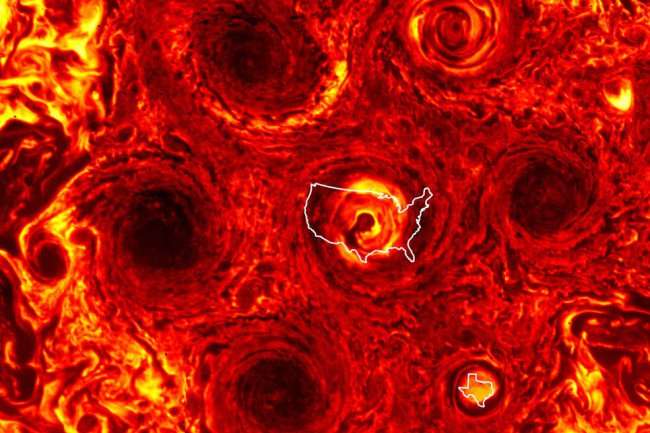The Juno spacecraft was launched in 2011 and entered orbit around Jupiter in 2016. Its primary mission is to understand how Jupiter formed and evolved over time. It is the first mission that can peer below the top layer of Jupiter’s clouds.Onboard Juno is a camera that can see the infrared light Jupiter emits from within its atmosphere. This camera lets scientists track the motions of gases below the planet’s surface. And with this latest research, the camera has revealed complex movement in Jupiter’s clouds that wasn’t known before.One of Juno’s first discoveries in 2016 was a series of enormous storms arranged in a pentagon around Jupiter’s south pole, with five cyclones surrounding a central one. Now, the mission has spotted a new storm that joined the fray, creating a hexagonal array of storms around the planet’s south pole. The central storm is roughly the size of the continental United States, while the newest storm is about the size of Texas.The arrangement of multiple storms at the gas giant’s pole was a surprise to planetary scientists. Based on simulations, they expected that a new storm popping up might trigger an episode of cannibalism, where multiple storms swallow one another to create one large vortex.But models show these storms may not dissipate anytime soon.When astronomers were simulating these structures and changed the sizes and strengths of "buffer zones" in the gases around the storms, the storms actually repelled each other enough to keep from merging. Their models showed how this new storm may have joined the circle of cyclones surrounding the central one without disrupting the arrangement.“The intruder becomes part of the family,” Caltech planetary scientist and Juno team member Cheng Li said during a press conference.Researchers don’t yet fully understand what causes the peculiar arrangement of storms on Jupiter. Future observations should let them create better-informed simulations and reveal the secrets of Jupiter’s polar storms.
NASA's Juno probe just discovered a Texas-sized cyclone on Jupiter

Sukeed on December 13rd, 2019 at 17:50 UTC »
I like how often Texas is used as a unit of measurement for Americans to understand that something is big
Oalka on December 13rd, 2019 at 17:19 UTC »
I seem to recall a video of someone with a cup of liquid reproducing a hexagonal turbulence effect, if I can find it I'll link it. It appears to be a natural harmonic reaction.
TDIsideHustle on December 13rd, 2019 at 16:52 UTC »
Strange... there is also a constant hexagonal storm on Saturn’s North Pole. What’s up with that??